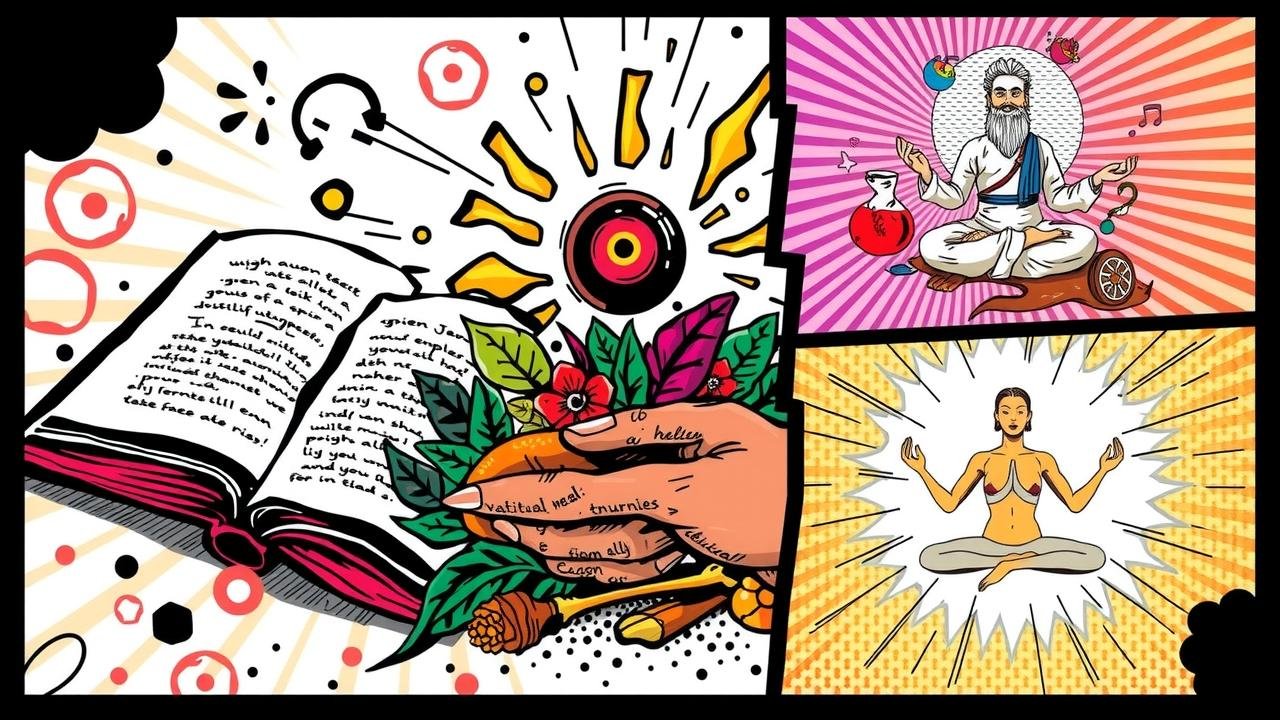Ayurveda: Tracing the Historical Path of an Ancient Indian Healing Tradition

Ayurveda, which means “knowledge of life,” has its roots in India over 5,000 years ago and is one of the oldest holistic healing practices known today. It draws from the Vedas, particularly the Rigveda, which include hymns and medicinal knowledge. Key texts like the Charaka Samhita focus on internal medicine while the Sushruta Samhita is seen as a basis for surgical techniques. Central to Ayurveda are the three doshas—Vata, Pitta, and Kapha—and the five elements that influence health. In modern times, there’s been a revival of interest as people seek alternative methods for wellness, making Ayurveda relevant worldwide today.
Origins of Ayurveda

Ayurveda, which translates to “knowledge of life,” has roots that trace back over 5,000 years in India. This ancient healing system is intertwined with the Vedas, particularly the Rigveda, which includes hymns that detail early medicinal practices. The foundational texts of Ayurveda, known as the Samhitas, were compiled around 500 BCE and include significant works like the Charaka Samhita and Sushruta Samhita. The Charaka Samhita focuses on internal medicine, offering insights into health and disease philosophy, while the Sushruta Samhita, attributed to Sushruta, is recognized for its surgical techniques and procedures. Philosophy plays a vital role in Ayurveda, with the balance of three doshas—Vata, Pitta, and Kapha—central to its practice. These doshas are energies that govern our physiological and psychological processes. Additionally, the concept of the five elements—earth, water, fire, air, and ether—underpins Ayurvedic thought, illustrating how the natural world influences health.
Development through Ancient Texts

Ayurveda’s development is deeply intertwined with its ancient texts, the Samhitas, which form the backbone of this healing tradition. Compiled around 500 BCE, these texts encapsulate centuries of knowledge and practices. The Charaka Samhita is one of the most significant texts, focusing on internal medicine and addressing the philosophy behind health and disease. It provides insights into the importance of balance in the body, emphasizing the role of diet and lifestyle in maintaining wellness. Meanwhile, the Sushruta Samhita, attributed to Sushruta, is renowned for its extensive contributions to surgery. It details various surgical techniques and instruments, showcasing a sophisticated understanding of human anatomy and medical procedures for its time. Another crucial text, the Ashtanga Hridaya, integrates diverse aspects of Ayurvedic medicine, presenting a comprehensive approach to health that includes preventive care. These ancient writings not only laid the foundation for Ayurveda but also reflect the evolving nature of medical knowledge in India, illustrating how different schools of thought contributed to its rich tapestry.
| Text Name | Focus/Content | Significance |
|---|---|---|
| Charaka Samhita | Internal medicine, philosophy of health and disease | Fundamental in understanding Ayurvedic medicine and its principles |
| Sushruta Samhita | Surgical techniques and procedures | Pioneered surgical practices, known as the ‘father of surgery’ |
| Ashtanga Hridaya | Integration of various aspects of Ayurvedic medicine | Comprehensive guide to health, treatment, and practice of Ayurveda |
Philosophical Foundations of Ayurveda
Ayurveda is deeply rooted in the philosophical belief that health is a balance of body, mind, and spirit. At its core are the three doshas: Vata, Pitta, and Kapha. These doshas represent different combinations of the five elements—earth, water, fire, air, and ether. Each dosha governs specific physiological and psychological functions. For instance, Vata, associated with air and space, influences movement and communication, while Pitta, linked to fire, governs digestion and metabolism. Kapha, related to water and earth, is responsible for structure and stability.
The interplay among these doshas affects an individual’s health and temperament. Ayurveda teaches that imbalances can lead to disease, emphasizing the importance of maintaining harmony. This balance is not just about physical health; it extends to emotional and spiritual well-being. In practice, Ayurvedic treatments often involve personalized diets and lifestyle changes tailored to an individual’s unique constitution, or Prakriti.
Furthermore, Ayurveda incorporates the principle of Sattva (purity), Rajas (activity), and Tamas (inertia) from ancient Indian philosophy, which influences mental states and overall health. By understanding these foundational concepts, practitioners work towards restoring balance and promoting a holistic approach to healing.
Historical Influence on Ayurveda
Ayurveda has evolved through centuries, absorbing influences from various cultures and medical traditions. During the Gupta period (around 320 to 550 CE), Ayurveda integrated knowledge from Greek and Chinese medicine, enriching its practices and philosophies. This exchange was facilitated by trade routes and the establishment of universities, which became centers for learning and knowledge sharing. For instance, the introduction of certain surgical techniques and herbal remedies from other cultures helped refine Ayurvedic practices. Additionally, the translation of Ayurvedic texts into other languages contributed to its spread beyond India. This historical blending of knowledge not only enhanced Ayurveda’s scope but also allowed it to adapt and remain relevant throughout changing times.
Modern Revival of Ayurvedic Practices
In the 20th century, Ayurveda experienced a significant revival, partly driven by a growing interest in holistic and alternative medicine. As people became disillusioned with conventional treatments, they turned to Ayurveda for its natural and personalized approach to health. This resurgence was not limited to India; it spread to the Western world, where individuals sought out Ayurvedic practices for wellness and preventive care. Health retreats and wellness centers began offering Ayurvedic treatments, such as herbal remedies and detoxification therapies like Panchakarma, making these ancient practices accessible to a global audience.
The recognition of Ayurveda by organizations like the World Health Organization (WHO) further propelled its acceptance. Today, many countries now integrate Ayurvedic principles into their healthcare systems, acknowledging its potential benefits alongside traditional medicine. Research into Ayurvedic practices is ongoing, with studies aiming to validate its efficacy through clinical trials. For instance, some studies have shown that Ayurvedic herbs can effectively manage conditions like arthritis and stress-related disorders.
Furthermore, the rise of digital platforms has made it easier for practitioners to share knowledge and for patients to seek Ayurvedic guidance from anywhere in the world. Online consultations and virtual wellness programs have allowed Ayurveda to adapt to modern lifestyles, ensuring that its rich tradition continues to thrive in contemporary health and wellness discussions.
Current Applications of Ayurveda
Ayurveda is increasingly being integrated into modern health practices around the world. Many wellness centers now offer Ayurvedic treatments, which include personalized consultations that assess an individual’s dosha balance. This approach allows practitioners to create tailored health plans that may involve dietary changes, herbal supplements, and lifestyle adjustments. For instance, someone with a Pitta dosha might be advised to consume cooling foods and avoid spicy dishes, while a Vata individual may benefit from grounding, nourishing meals.
Panchakarma, a key Ayurvedic detoxification therapy, is gaining traction for its rejuvenating effects. It typically involves five cleansing procedures to remove toxins from the body and restore balance. People seeking stress relief often turn to Ayurvedic practices such as meditation, yoga, and breathing exercises, which are aligned with its holistic philosophy.
Furthermore, research into herbal remedies like Ashwagandha and Turmeric is underway, showcasing their potential benefits in reducing stress and inflammation. The WHO’s recognition of Ayurveda as a complementary health system further legitimizes its practices, encouraging more healthcare providers to incorporate Ayurvedic principles into their services. As a result, Ayurveda is being embraced not just as an alternative healing method but as a valuable complement to conventional medicine.
- Ayurvedic dietary practices focusing on individual constitution (Prakriti)
- Use of herbal remedies and natural supplements
- Personalized treatments aimed at balancing the doshas (Vata, Pitta, Kapha)
- Detoxification therapies like Panchakarma
- Integration of yoga and meditation for holistic health
- Treatment of chronic conditions such as arthritis and digestive disorders
- Promotion of mental well-being through mindfulness and stress management techniques
Global Acceptance and Influence of Ayurveda
Ayurveda’s global acceptance has been remarkable, evolving from its roots in ancient India to a respected system of alternative medicine worldwide. Wellness centers and practitioners now offer Ayurvedic therapies in countries such as the United States, Canada, and various European nations. This surge in popularity is partly due to a growing interest in holistic health and natural remedies, appealing to those seeking alternatives to conventional medicine. For example, Ayurvedic practices like Abhyanga (oil massage) and Shirodhara (oil pouring on the forehead) have become popular for relaxation and stress relief. Furthermore, research has started to validate Ayurvedic principles, with clinical studies exploring the effectiveness of herbal treatments and dietary recommendations. As a result, many hospitals and wellness facilities are incorporating Ayurvedic methods into their treatment plans, acknowledging its potential benefits alongside modern medical practices.
Ayurveda’s Journey Through Time
Ayurveda’s evolution is marked by its ability to adapt and integrate various cultural influences while maintaining its core principles. During the Gupta period, for example, Ayurveda absorbed elements from Greek and Chinese medicine, enhancing its practices and expanding its reach. This cross-pollination of ideas was facilitated by trade routes that connected India to other civilizations, allowing for a rich exchange of knowledge. The establishment of renowned universities during this era also played a crucial role in the formalization and dissemination of Ayurvedic teachings. As scholars and practitioners collaborated, they refined surgical techniques and medicinal formulations, laying the groundwork for Ayurveda to thrive.
The historical significance of Ayurveda is further underscored by its continued relevance in modern times. In the 20th century, as people began to seek alternatives to conventional medicine, Ayurveda experienced a renaissance. This revival was not just limited to India; it sparked global interest, leading to the establishment of wellness centers worldwide that offer Ayurvedic therapies. Today, Ayurveda is not only a respected traditional practice but also a subject of scientific research, with studies validating its approaches and outcomes. The journey of Ayurveda through time showcases its resilience and its commitment to holistic health, proving that ancient wisdom can coexist with contemporary medical practices.
Frequently Asked Questions
1. What is Ayurveda and how did it start?
Ayurveda is an ancient Indian healing system that aims to balance the body, mind, and spirit. It started over 3,000 years ago and is based on natural remedies, diet, and lifestyle adjustments.
2. What are the main concepts behind Ayurveda?
The main concepts of Ayurveda include the idea of doshas, which are the three energies (Vata, Pitta, and Kapha) that influence our health. It also emphasizes balance, prevention, and personalizing treatments based on an individual’s unique constitution.
3. How does Ayurveda differ from modern medicine?
Ayurveda focuses on holistic healing and treating the root cause of health issues, rather than just symptoms. In contrast, modern medicine often focuses on diagnosing and treating specific diseases with medications and surgeries.
4. Can anyone practice Ayurveda?
Yes, anyone can learn about and incorporate Ayurvedic principles into their life. However, it’s best to consult with a trained Ayurvedic practitioner for personalized advice and treatments.
5. What are some common Ayurvedic practices?
Common Ayurvedic practices include herbal remedies, yoga, meditation, dietary changes, and detoxification methods such as Panchakarma, which help to cleanse the body and promote overall wellness.
TL;DR Ayurveda, an ancient Indian healing tradition over 5,000 years old, emphasizes holistic health through balance and personalized treatments. Originating from the Vedas, it developed through key texts like the Charaka and Sushruta Samhitas, influencing and being influenced by other medical systems throughout history. Modern recognition has led to a revival and global acceptance, integrating its practices into various health care systems today.




























































































